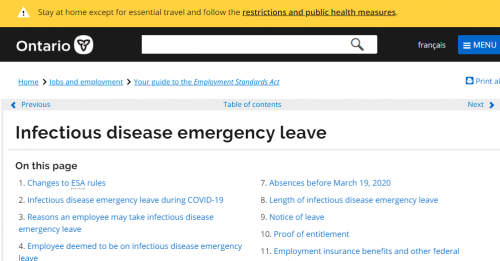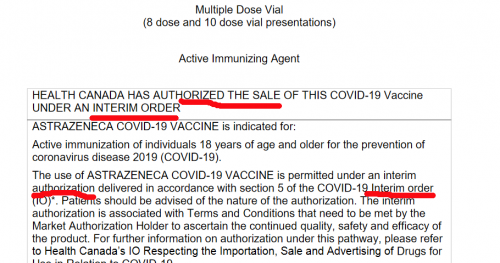
Worker rights are always important, especially if employers want to mandate they take experimental, unapproved gene replacement therapy. But what does the Ontario Government have to say?
https://www.ontario.ca/laws/regulation/r20228
https://archive.is/pZoao (May 29, 2020)
https://files.ontario.ca/books/ontariogazette_153-24.pdf
Ontario Gazette June 13 Page 59 ESA Protections
https://archive.is/A03GF (March 2, 2021)
https://www.ontario.ca/laws/regulation/r20228 (as of today)
https://archive.is/6atpm (as of today)
Section 30.1, Canada Food & Drug Act
Interim (Emergency) Order Signed By Patty Hajdu
https://covid-vaccine.canada.ca/info/pdf/astrazeneca-covid-19-vaccine-pm-en.pdf
https://covid-vaccine.canada.ca/info/pdf/janssen-covid-19-vaccine-pm-en.pdf
https://covid-vaccine.canada.ca/info/pdf/covid-19-vaccine-moderna-pm-en.pdf
https://covid-vaccine.canada.ca/info/pdf/pfizer-biontech-covid-19-vaccine-pm1-en.pdf
The Infectious Disease Emergency Leave Provisions of the Employment Standards Act came into effect in May 2020. They were written up to be retroactive to January 2020. Sounds reasonable enough.
Now, this portion of the Ontario Employment Standards Act has undergone revision, several times. That being said, there is one particularly interesting provision. Specifically: protections were put in, then removed, for workers who don’t want to receive the “vaccine”.


Reasons an employee may take infectious disease emergency leave
.
Employees can take infectious disease emergency leave if they will not be performing the duties of their position because of any of the following reasons:
.
(4) The employee is under a direction given by their employer in response to the employer’s concern that the employee might expose other individuals in the workplace to a designated infectious disease. The ESA does not require employers to pay employees during that time.
Examples include where the employer:
(a) is concerned that employees who have not received the COVID-19 vaccine may expose others in the workplace to COVID-19 and tells them not to come to work until they have been vaccinated
(b) directed an employee to stay at home for a period of time if the employee has recently travelled internationally and the employer is concerned the employee may expose others in the workplace to a designated infectious disease
Reasons an employee may take infectious disease emergency leave
.
(4) The employee is under a direction given by their employer in response to the employer’s concern that the employee might expose other individuals in the workplace to a designated infectious disease. The ESA does not require employers to pay employees during that time.
.
Examples include where the employer directed an employee to stay at home for a period of time if the employee has recently travelled internationally and the employer is concerned the employee may expose others in the workplace to a designated infectious disease
The top quote is how the March 2, 2021, and the lower quote is how the law currently reads. The April 2021 update keeps the provision for international travel, but removes the protection for workers who don’t want to be vaccinated.
Now, it could be argued that this removal isn’t conclusive, and that the Government still could enforce such protections anyway. In that case, why was it removed then? The people drafting it saw a need to specifically include protections against forced vaccination. There was a concern they were addressing. Then they specifically wrote it out.
To further make this point, consider these categories:
(a) Approved: Health Canada has fully reviewed all the testing, and steps have been done, with the final determination that it can be used for the general population
(b) Interim Authorization: deemed to be “worth the risk” under the circumstances, doesn’t have to be fully tested. Allowed under Section 30.1 of the Canada Food & Drug Act. Commonly referred to as an emergency use authorization.

These “vaccines” fall under the second category. They were authorized under a temporary order, because politicians declared that it was worth the risk. They are not, and have never been, approved.
And Doug Ford’s Government removed protections for workers that would have provided cover from bosses who make this demand. Once again, these were never approved, and simply given temporary authorization. So much for his slogan: “For The People”.
Discover more from Canuck Law
Subscribe to get the latest posts sent to your email.
